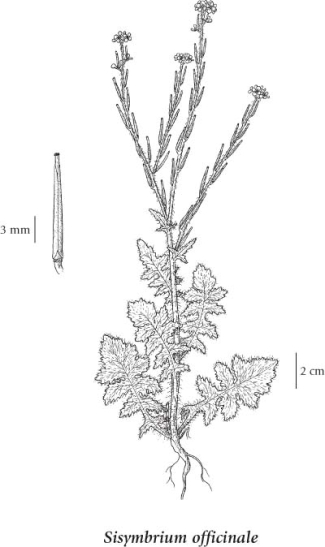Sisymbrium officinale (L.) Scop.
hedge mustard (hedgemustard)
Brassicaceae (Mustard family)
Introduction to Vascular Plants
hedge mustard (hedgemustard)
Brassicaceae (Mustard family)
Introduction to Vascular Plants
Species Information
General:
Annual herb from a taproot; stems 0.2-1.0 m tall, simple to (more commonly) loosely branched, stiff, usually strongly stiff-hairy with backward-pointing or spreading hairs.
Leaves:
Basal leaves oblanceolate, 4-25 cm long, 1-6 cm wide, pinnately-cut, terminal lobe the largest and more or less egg-shaped and shallowly round-toothed, glabrate to sparsely hairy; stem leaves usually unstalked, much reduced, generally with 4-6 linear to narrowly lanceolate lobes, terminal lobes more deltoid-lanceolate.
Flowers:
Racemes elongate in fruit, as much as 35 cm long; petals pale yellow, 3-4 mm long; sepals 1.5-2.5 mm long, oblong-oblanceolate.
Fruits:
Siliques, erect, 8-15 mm long, 1-1.5 mm wide, linear and awn-like, tightly appressed, beaked, sparsely hairy to glabrous; segments 3-nerved, tardily dehiscent; fruiting stalks erect, 1-3 mm long, stout, enlarged at the tips and about as thick as siliques; beaks 1-2 mm long; seeds about 1.3 mm long, plump, not gelatinous when wet.
Illustration

If more than one illustration is available for a species (e.g., separate illustrations were provided for two subspecies) then links to the separate images will be provided below. Note that individual subspecies or varietal illustrations are not always available.
Illustration Source: The Illustrated Flora of British Columbia
Ecology
Ecological Framework for Sisymbrium officinale
The table below shows the species-specific information calculated from
original data (BEC database) provided by the BC Ministry of Forests and Range.
(Updated August, 2013)
The table below shows the species-specific information calculated from
original data (BEC database) provided by the BC Ministry of Forests and Range.
(Updated August, 2013)
| Site Information |
Value / Class |
||
|
Avg |
Min |
Max |
|
| Elevation
(metres) |
615 | 615 | 615 |
| Slope
Gradient (%) |
5 | 5 | 5 |
|
Aspect (degrees) |
294 | 295 | 295 |
| Soil
Moisture Regime (SMR) [0 - very xeric; 4 - mesic; 8 - hydric] |
5 | 5 | 5 |
| Modal
Nutrient Regime
Class |
D | ||
| #
of field plots species was recorded in: |
2 | ||
| Modal
BEC Zone Class |
BG | ||
|
All BEC Zones (# of stations/zone) species was recorded in |
BG(1) | ||
|
Source:
Klinkenberg 2013
|
|||
Habitat and Range
Mesic to dry fields and waste places in the lowland zone; frequent in SW BC, infrequent in SC BC; introduced from Eurasia.Status Information
Synonyms
Synonyms and Alternate Names:
Erysimum officinale L.
Sisymbrium officinale var. leiocarpum DC.